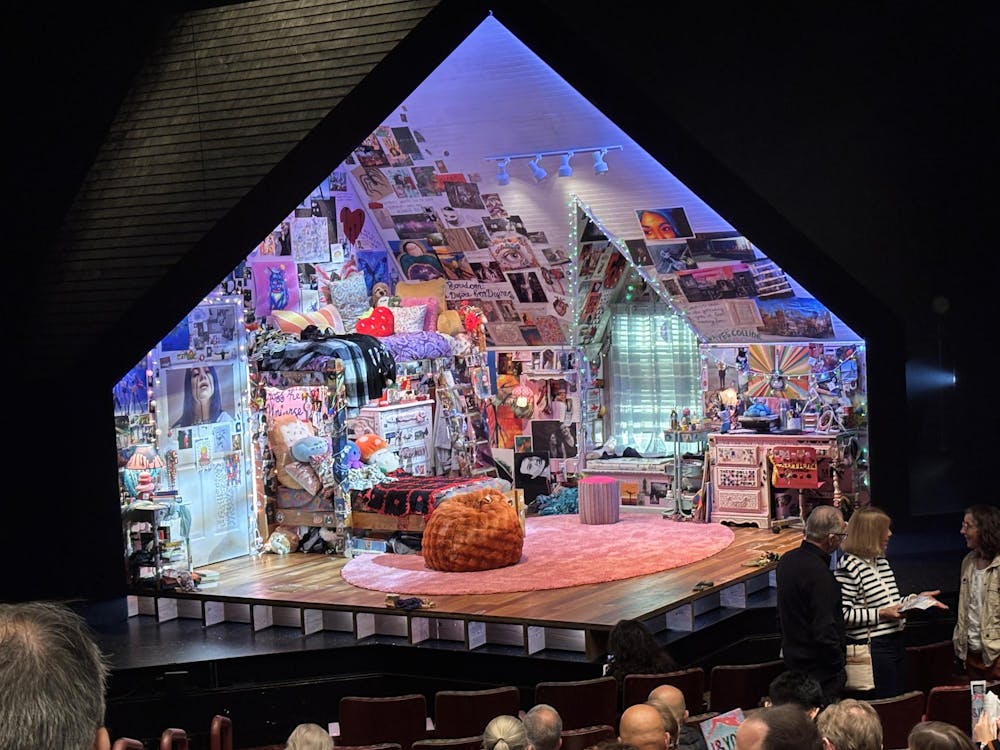With splashes of hot pink and deep blue enlivening the set; a myriad of grungy, vibrant posters spanning the walls; and lots of twinkling neon fairy lights, the perfect word to describe “I&You: The Musical” is “colorful.”
Showing Sep. 13 to Oct. 12 in Berlind Theatre, “I & You: The Musical” tells the heartfelt and enthralling story of an encounter between two high school students, Caroline and Anthony, who bond while rushing to complete a class project about Walt Whitman’s poem “Song of Myself” the night before it’s due. The musical was commissioned by McCarter Theatre and written by playwright Lauren Gunderson.
Caroline — played by Jasmine Forsberg — suffers from a chronic liver disease and has been out of school for most of her life. She’s easily irritable, sassy, and most of all, lonely. On the other hand, Anthony — portrayed by Benji Santiago — is clumsy but well-intentioned, and predominantly occupied with school and basketball.
The show begins with the number “Caroline,” in which the female lead, lying on her bunk bed, expresses her moodiness. She is dramatically interrupted when curly-headed jock Anthony bursts through her door, banking on the art-savvy Caroline to rescue his project.
Unfortunately for Anthony, Caroline hates poetry, doesn’t know who Walt Whitman is, and most importantly, despises “nice” people and “niceties.” To her, Anthony is just a “pretty boy” who only knows how to flash a smile and count on his luck. Perhaps his smile is more charming than she initially thought — or maybe it’s the waffle fries he offers her— because Caroline eventually begrudgingly agrees to help him.
From there, the two bicker, tumble around the stage, read excerpts from “Song of Myself” together, and eventually bond over Whitman being a “badass.” Their growing connection begins to spark with the number “Every Atom,” and builds in “Spotted Hawk” and “Know Me Like That.” Forsberg’s theatrical and vocal performance in every song was striking. Of particular note was her incorporation of vocal runs that mimicked a hawk in “Spotted Hawk,” which were incredibly realistic, yet somehow blended seamlessly with the rest of the singing.
Apart from the music, I also particularly appreciated Caroline’s character development. She wasn’t bound to the stereotypical and restricting limits of being the “sick character,” with Gunderson finding plenty of avenues to honor what the character might have done with an abundance of free time. However, there were some unsatisfying moments relating to her character — for example, an especially sentimental moment when she surprises Anthony by playing the guitar, beginning to reveal personal details such as how she used to love American Girl dolls and her favorite flavor of ice cream, Chunky Monkey. While I appreciated the moment, this scene felt superficial and surface-level. The facts Caroline shared felt like a gimmicky way to score sympathetic brownie points with the audience without actually revealing anything about her as a character.
On a more positive note, I loved the meaning of the title, “I&You.” In the poem “Song of Myself,” Whitman uses the pronouns “I” and “you” interchangeably: “For every atom belonging to me as good belongs to you,” for example. This ties neatly back into Caroline and Anthony’s blossoming relationship. Although the duo is worlds apart in terms of personality, they complement and complete each other — which becomes literal by the end of the musical (spoilers!).
Just as they’re both becoming semi-cognizant of their feelings, Anthony takes a step back. The show shifts into a much darker tone as he sings “I and This Mystery,” revealing that a member of his basketball team recently died on the court. The rest of the musical operates on higher stakes as the two navigate not only Anthony’s ability to process the events, but also face the implications of Caroline’s growing sickness.
While the overall premise of the play was slightly overdone, the show’s production features some of the most dynamic technical elements I’ve ever witnessed. A projector in the background serves as a complementary visual aid throughout most of the musical, displaying stars, colorful waves, and a plethora of other stimuli (and stealing the show during the second to last scene). The most surprising element of the set by far is that it literally comes apart: in the final scene, the roof of the room lifts into the ceiling, and each side of the set spins off in opposite directions. Despite the play’s writing sometimes drifting into the predictable, the final projector scene and visual effects alone were worth the watch for an amateur musical-goer like me.
Kaichen Chou, member of the Class of 2029, is a contributing writer for the Prospect and a copy staffer. She can be reached at kc2050[at]princeton.edu.
Please send corrections to corrections[at]dailyprincetonian.com.









